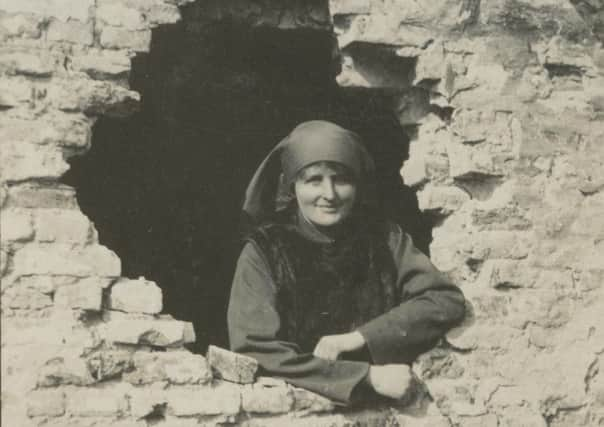The front-line WWI heroine aged 18


Mairi Chisholm set off for London on her motorbike to try to join the war effort at the outbreak of the conflict in 1914.
She went on to become one of just two women who lived and worked on the front line in the First World War – from a first-aid station she set up in a house near Ypres, Belgium, with one of her best friends.
Advertisement
Hide AdAdvertisement
Hide AdMiss Chisholm, from Nairn, and Elsie Knocker, whom she met in Devon after her family moved there from Scotland, were dubbed the “Madonnas of Pervyse” by the Belgians, for their four-year effort.
Now, a selection of her photo albums and sketch books are going on display at the National Library of Scotland in Edinburgh as part of its 100th anniversary commemorations.
The show, which runs until Armistice Day on 11 November, features a host of little-seen letters, diaries, journals, postcards, recruiting posters, propaganda material and film footage.
All the material has been drawn together for the first time for the exhibition, which features more than 30 first-hand accounts of the war from those whose lives were touched by it.
Miss Chisholm and Miss Knocker, who were 18 and 28 respectively in 1914, got jobs as despatch riders when they arrived in London thanks to their experience of riding motorbikes.
However their lives were changed when Ms Chisholm was spotted by Dr Hector Munro, the founder of the Flying Ambulance Corps, which was set up to transport troops from the battlefield to hospitals.
When he asked her to travel out to Belgium, she also recommended her friend, who was also a trained nurse.
Alison Metcalfe, manuscripts curator at the National Library, said: “They went off to Belgium as ambulance drivers initially and served there for a couple of months, but Elsie realised that men were really suffering from their injuries in the journeys back from the front line. They would have been dressing some horrific wounds and, for quite a lot of the men, there wasn’t much that they could do for them.
Advertisement
Hide AdAdvertisement
Hide Ad“Although Elsie was a trained nurse, Mairi did not have any medical experience at all – she just had to pick it up.
“They remained there until March 1918, when there was a lot more action close to where they were. They were gassed out once and returned after they made a recovery, but then the Belgian government felt it was too dangerous for them.”
Other highlights include a rare chance to see extracts of the war diaries kept by Field Marshal Earl Haig, the commander-in-chief of the British Army. Notable stories featured include those of Edinburgh-born brothers Archie and Bertie Dickson, who served in the Battle of Jutland, the biggest naval battle of the war, where Archie was killed at the age of 16.
Bertie carried a photograph of Archie – which is featured in the exhibition – with him for the rest of his life.
Among the propaganda material on display are books and pamphlets penned by Perth-born John Buchanan, author of The Thirty-Nine Steps, who became director of the government’s Ministry of Information.
The exhibition features an extensive section on conscientious objectors and the punishments they faced, including Arthur Woodburn and Emrys Hughes, who became Labour MPs after being jailed for their refusal to join the war effort.
Jan Usher, the library’s social sciences curator, added: “It’s impossible to tell the full story of the war in a single exhibition.
“What we’ve tried to do is tounderstand it through the records that people left behind of their experiences.”